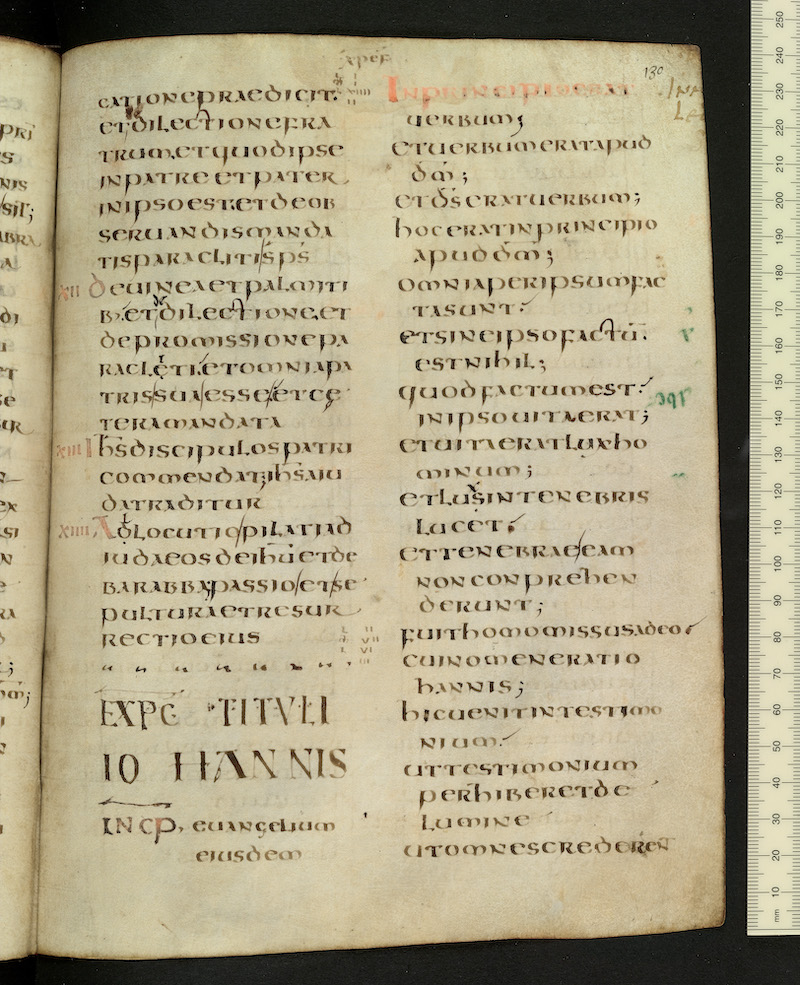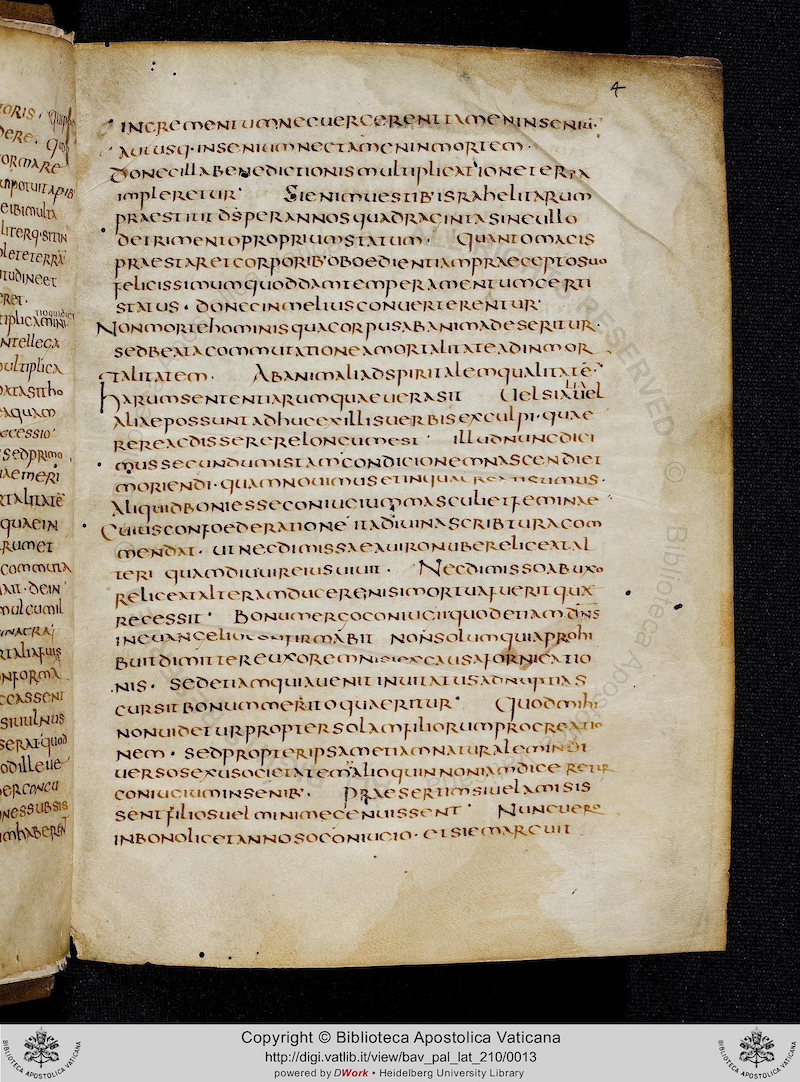
Caroline Minuscule; Square Capitals; Uncial, 9th century
-
Title
Walafrid Strabo, Expositio in viginti primos psalmos -
Text
Commentary on Ps. 1:1-2 -
Language(s)
Latin -
Writing System
Roman -
Script(s)
Caroline Minuscule; Square Capitals; Uncial -
Country
Switzerland -
City
St. Gall -
Repository
Stiftsbibliothek -
Shelf Mark
317, page 9 -
Century
9th century -
Year Range
800-900 -
Place Of Origin
Switzerland, St. Gall -
Bibliography
Albert Bruckner, Scriptoria Medii Aevi Helvetica 3, Schreibschulen der Diözese Konstanz, St. Gallen II (1938), 95.
Patrologia Latina vol. 114, cols. 752C-753B
-
External Facsimile
This St. Gall manuscript from the middle of the 9th century is written in a Caroline minuscule that shows some traces of Alemannic minuscule, the pre-Caroline script developed at St. Gall and neighboring monasteries. In particular, the scribe occasionally uses the "cc" form of a as well as the normal Caroline a, which has a loop at the left and a slanting stroke from minim height to baseline at the right.
Wide spacing between clauses and sentences, litterae notabiliores, and an unusually extensive repertoire of punctuation articulate the text. The lemma — the opening of Psalm 1, on which this page's text is commenting — is set off by a 6-line initial B and lines in alternating red and blue ink. The hierarchy of scripts within these lines is somewhat unorthodox, compared to contemporary examples from Tours. The first two lines mix Square Capital and Uncial forms (the latter in the case of e and m), and the hierarchy continues down to minuscule for the second verse of the psalm.
The large hole in the page is from damage to the animal whose skin became the parchment.
Acknowledgements: Described by Carin Ruff
Transcription
1 BEATUS VIR QVI NON
2 ABIIT IN CONSILIO IMPIORUM ∙ ET IN UI(-)
3 A PECCATORUM NON STETIT ∙ ET IN CATHE(-)
4 DRA PESTILENTIȨ NON SEDIT ∙7
5 Sed in lege d(omi)ni uoluntas eius ∙´et in lege eius meditabitur
6 die ac nocte ∙7
7 Omnis scriptura diuinitus inspirata ueteris ac noui testamen(-)
8 ti ∙ ad imitationem mediatoris d(e)i et hominu(m) ∙ hominis chr(ist)i ie(s)u fideles
9 inuitat ∙7 Vt per imitationem ad similitudinem eius peruenire me(-)
10 reantur ∙ Sicut ipse ait ∙, Si quis mihi ministrat me sequatur Siquis mihi ministrat ∙´ et ubi
11 sum ego illic et minister meus erit ∙ Et ap(osto)l(u)s atq(ue) euangelista iohan(-)
12 nes ∙´ k(arissi)mi ait∙ ; Nunc filii d(e)i sumus ∙ et nondum aparuit quid erimus ∙
13 Scimus quia cum aparuerit similes ei erimus ∙ quo(niam) uidebimus eum
14 sicuti est ∙ 7 Sic ergo et hic primus psalmus docet credentes ut auc(-)
15 torem et largitorem uere beatitudinis sequantur ∙ declinando mala et
16 faciendo bona ∙ ut perueniant ad similitudinem eius ∙´et fiant
17 Ta[n/m]quam lignum plantatum secus decursus aquarum ∙ 7 Perfec(-)
18 tae autem declinet a malo qui nec delectatur in corde ∙ nec agit in ope(-)
19 re ∙ nec alios docet ut faciant ∙ 7 Hoc est enim non abire in consilio im(-)
20 iorum ∙´ Nec stare in uia peccatorum .´ Nec sedere in cathedra pes(-)
21 tilentiae ∙´ Sed potius meditari in lege d(omi)ni . 7 Non necessitate sed uo(-)
22 luntate ∙´ sine cessatione quod significat die ac nocte ∙ 7 Vel sicut so(-)
23 let scriptura diem /p(ro)\ prosperis ∙ et noctem pro aduersis ponere ∙
24 Vt neq(ue) laetitia rerum temporalium ∙´Nequȩ aduersitas
25 transitoria\:/∙ mentem sequentis d(omi)n(u)m auertat a meditatione
26 diuine legis ∙7 quae quantum sit necessaria ∙ etiam ibi osten(-)
27 tur ∙ Vbi iosue ministro et conscio legislatoris qui legem primus
28 et prime didicerat ∙ 7 D(omi)n(u)s praecepit ut uolumen legis non deserat ∙´sed
29 meditetur in illo diebus ac noctibus ∙ ut dirigat uiam suam et intellegat
30 cuncta quae agit ∙7 Si autem apertius quis requirit quod sit consiliu(m)
Paleographic Features
1. In line 2 of the heading, the script changes from Square Capitals to Uncials in the course of this line.
2. In euangelista near the end of the fourth line of the main text, you can see the "cc" form of a – an older form, which this scribe occasionally uses amongst the Caroline as. (The normal Caroline a is in the words before and after this one.)
3. Eight lines from the bottom, after diem, a "pro" abbreviation has been inserted (probably by the original scribe) to correct a haplography: the scribe wrote only one pro when he should have written two ("pro prosperis").
4. Six lines from the bottom, the two dots below the space after transitoria probably signal an intended correction which the scribe forgot to complete. Transitoria should read transitoriarum.



